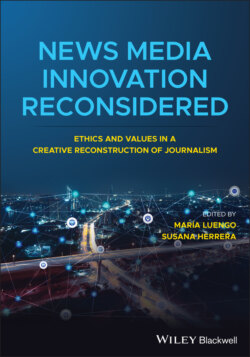Читать книгу News Media Innovation Reconsidered - Группа авторов - Страница 36
The Method
ОглавлениеDemocratically engaged journalism is distinct in its attachment to dialogic, egalitarian democracy. It is also distinct in combining that attachment with a commitment to objective methods in practice. Democratic journalists should guide their actions and work by the best standards of objective inquiry. They should be objectively engaged journalists.
This is not the narrow objectivity of the codes of professional journalism created a century ago. Objectivity is not the passive, un-interpreted observation of external facts. Humans possess no such capacity for observing pure facts. Moreover, neutrality is not the best stance for a social engaged practice like journalism. Any significant piece of journalism—in fact, any story—is an interpretation of some person, place, event, or issue. It mixes facts, perspective, judgments about credible sources, and the evaluation of rival opinions. It requires the selection of story “angle” and emphasis. The very language one uses to tell the story reflects perspective and judgment.
Moreover, the evaluation of interpretations is different from neutrally stripping stories down to bare facts. It requires a holistic set of criteria for evaluating to what degree a story (a) fits reality, (b) is coherent with existing knowledge, and (c) is able to withstand sustained public scrutiny. Criteria that assist judgments about (a) to (c) go beyond the criterion of expressing facts. They include norms of conceptual clarity, completeness of fact—the story contains the most important facts—a proper context for facts, and the logical coherence of statements within the story. This is the same type of objectivity that today guides scientific and other forms of active investigation into the world.
Moreover, this type of engaged objectivity is thwarted if one adopts a strict neutrality. The correct stance for democratically engaged journalism is impartiality, understood as not allowing one’s pre-existing partialities to prejudge the facts, angle, or conclusions of a story. Unlike neutrality, impartiality allows perspectives to be adopted and conclusions to be drawn, if they are informed by sufficient investigation.
In previous writings, I developed a detailed theory of this situated method of objectivity which I call “pragmatic objectivity” because it is designed for practices such as journalism.24 Condensed for this chapter, pragmatic objectivity can be described as the application of two things to practice: adopting an objective stance toward stories, and then testing stories by applying a set of evaluative norms. The objective stance is a willingness to adopt certain attitudes or “cognitive virtues” which allow us to step back from beliefs, claims, and theories. The cognitive virtues include a willingness to be impartial, and acceptance of the “burdens of judgment” when making public statements. The burdens include the need to verify facts and to provide good evidence for claims.25 The objective stance also requires inquirers to be passionately and genuinely interested in truth-seeking, which shows itself in a willingness to follow the facts where they lead and to alter one’s views as the evidence dictates.
However, adopting the objective stance is not sufficient for objectivity. The inquirer has to apply that stance to actual stories. That is, journalistic inquirers evaluate their interpretations by testing for accuracy, by seeking cross-verification from multiple sources, by questioning the origin of information, by providing fair representations of other people’s views, and so on. Journalists are objective if they adopt the objective stance and use objective norms to test interpretations.
Pragmatic objectivity suits today’s journalism because it is a flexible method that can be applied to different kinds of journalism, from reporting to analysis to civic engaged journalism. The norms of disengaged, neutral journalism apply only to fact-stating, straight reporting. Pragmatic objectivity works against dogmatism, sloppy reporting, entrenched biases, and a refusal to learn from other perspectives. Regrettably, we have too little pragmatic objectivity in the public sphere, among journalists and citizens.
